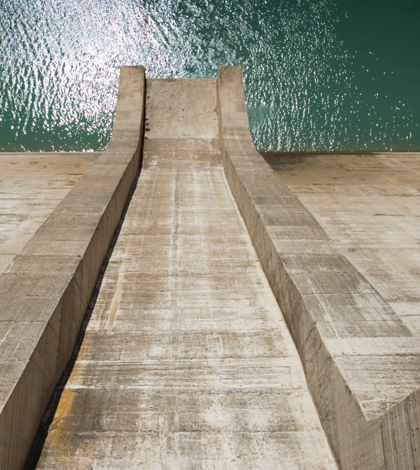Spillway Completion Marks Major Milestone
Having completed the spillway of the new Calaveras Dam project–a major milestone in the projected $810 million dam project—construction crews can now move forward in constructing the 220-foot high earth and rock-fill dam. The new spillway, near the Alameda-Santa Clara county line, is described as wide as eight freeway lanes and extending a quarter mile in length.
The Calaveras Reservoir is the largest reservoir in the Hetch Hetchy Regional Water System (HHRWS). Owned and operated by the San Francisco Public Utilities Commission (SFPUC), the Calaveras Reservoir, when full, is the largest drinking water reservoir in the Bay Area and provides water to over two-and-half-million Bay Area customers including those in Santa Clara County. The repair, replacement and seismic upgrades of the Calaveras Dam Replacement Project is part of the $4.8 billion Water System Improvement Program (WSIP) of the HHRWS.
The existing Calaveras Dam is 91-years old and located approximately 1,500 feet from the active Calaveras Earthquake Fault. When built in 1925 the Calaveras Dam was the tallest earth-filled dam and created a three-mile lake. In 2001 the California Division of Safety of Dams declared the Calaveras Dam seismically unsafe and the SFPUC lowered the reservoir’s water level to less than 40 percent of its normal operating capacity.
Dan Wade, director of the SFPUC’s Water System Improvement Program, indicated that when the original dam was built in 1925, “They knew the fault was there but they knew less about it than we know now.”
Upon completion of the entire Calaveras Dam Replacement Project it will have a structural height of 220 feet, a crest length of 1, 120 feet with a width of 80 feet at the crest and 1,180 feet at its base. The new dam is being built 400 yards downstream from the old dam. The old dam will be left in place and submerged underwater. When the project is completed the Calaveras Reservoir will be restored to 96,850 acre feet (31 billion gallons) which is its historic nominal storage capacity. Ninety percent of the materials for the dam will come from on-site borrow areas but some 300,000 cubic yards of sand and gravel will be imported to the site.
The new dam will also allow the release of temperature controlled water and necessary flow rates depending of the life cycle of fish in Alameda Creek. Fish screens and a fish ladder will be installed at the Alameda Creek Diversion Dam to help facilitate restoration of Steelhead Trout in the Alameda Creek Watershed.
The spillway has taken five years to complete after delays and additional costs were experienced due to complications when ancient landslides were discovered during construction. Completion of the spillway— effectively a massive overflow canal—protects the region if the reservoir fills to capacity. The spillway’s capacity means water doesn’t crest and spill over the top of the dam into nearby Fremont or onto Interstate 880.
Construction of the spillway utilized 40,000 cubic yards of concrete and now stretches 1,550 feet in length. With the completion of spillway construction will now begin on the dam. Completion is expected in 2019.
 California Water News Daily Your Source For Water News in California
California Water News Daily Your Source For Water News in California


